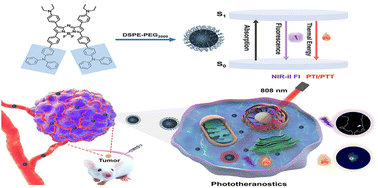An aza-BODIPY-based NIR-II luminogen enables efficient phototheranostics†
Abstract
The fabrication of a high-performance second near-infrared (NIR-II) biological window fluorophore is in urgent need for precise diagnosis and treatment of cancer. Nevertheless, the construction of phototherapeutic agents in the NIR-II region with excellent imaging performance and minimal side effects remains a big challenge due to the limited availability of core fluorophore candidates. In this study, a new NIR-II fluorescent probe, CB1, which is an aza-BODIPY core conjugated with bulky donors, was designed and synthesized. CB1 was further encapsulated in DSPE-PEG2000 to impart water solubility, which shows brighter NIR-II fluorescence and higher photostability than the clinically used indocyanine green (ICG). CB1 nanoparticles show deep tissue penetration and high imaging contrast in vivo. In addition, molecular conformation enables CB1 nanoparticles to exhibit good photothermal properties. Both in vitro and in vivo assessments confirm that CB1 nanoparticles could be utilized as distinguished theranostic agents for NIR-II fluorescence imaging and tumor growth inhibition with negligible side effects. Collectively, this work provides a promising approach for constructing a new platform for cancer diagnosis and therapy.

- This article is part of the themed collection: Biomaterials Science Most Popular 2022


 Please wait while we load your content...
Please wait while we load your content...